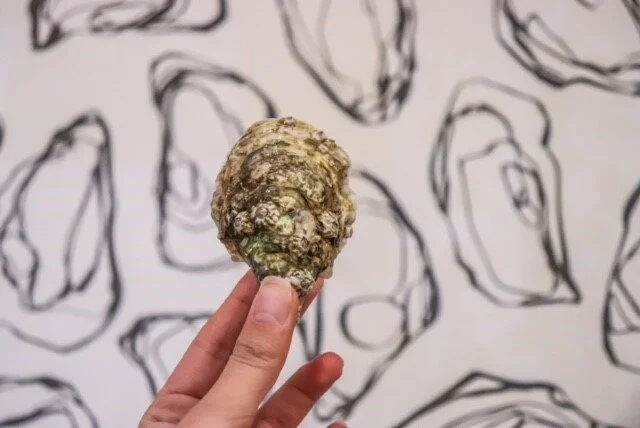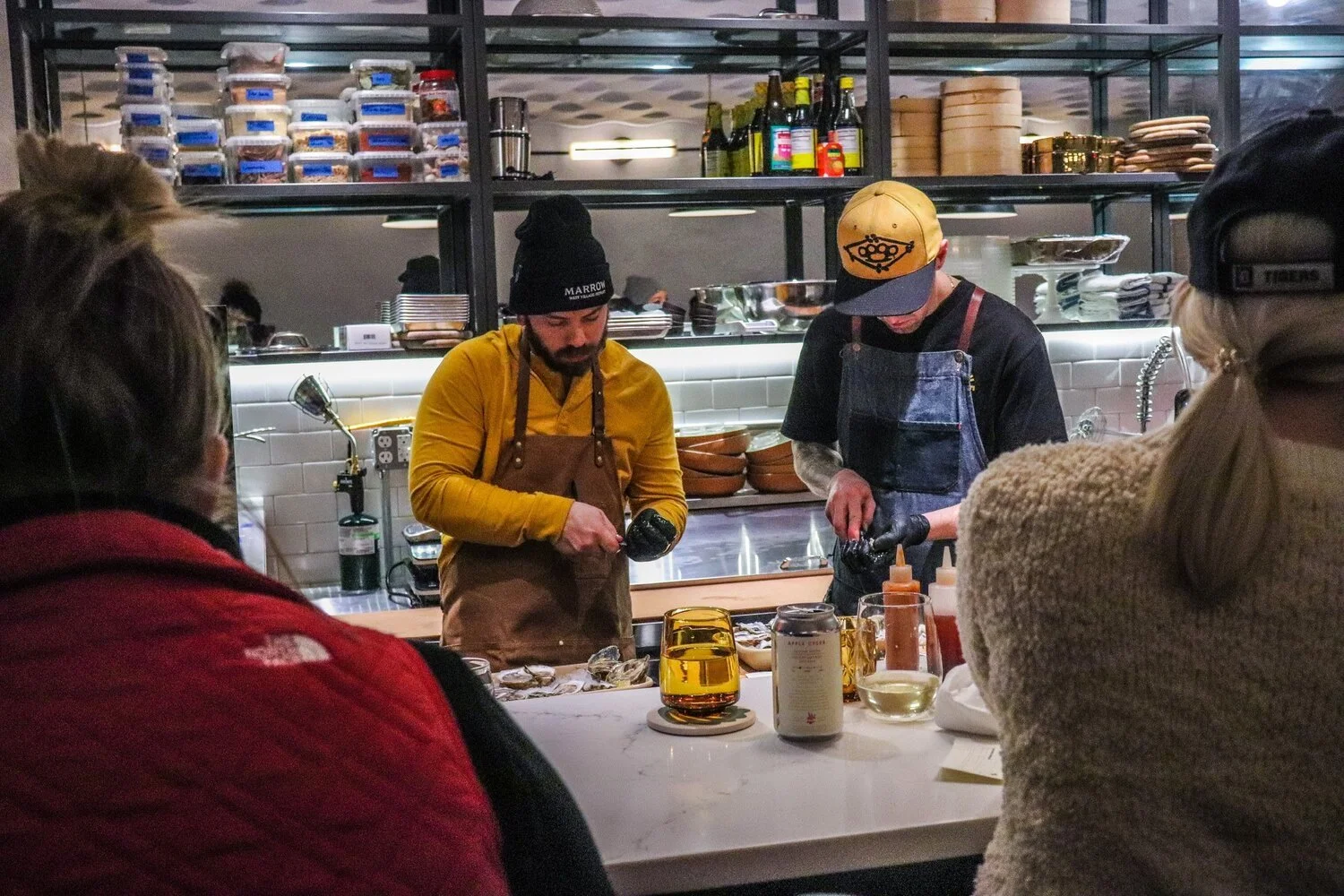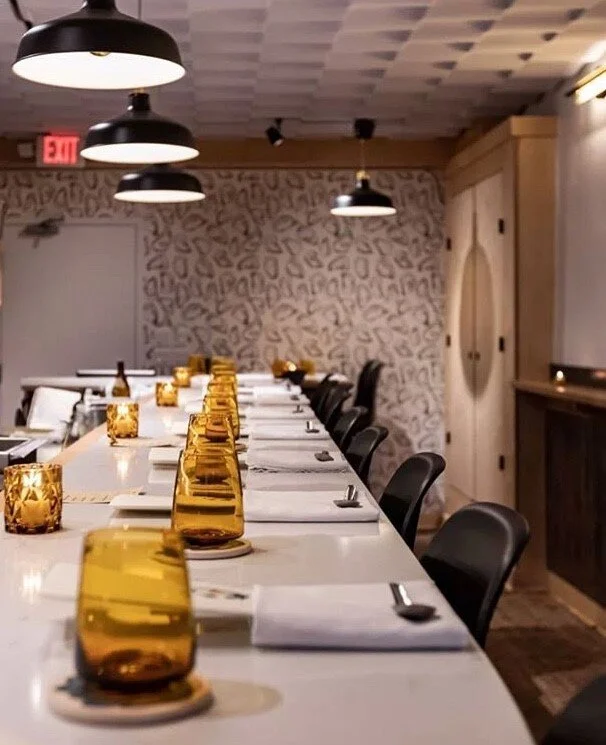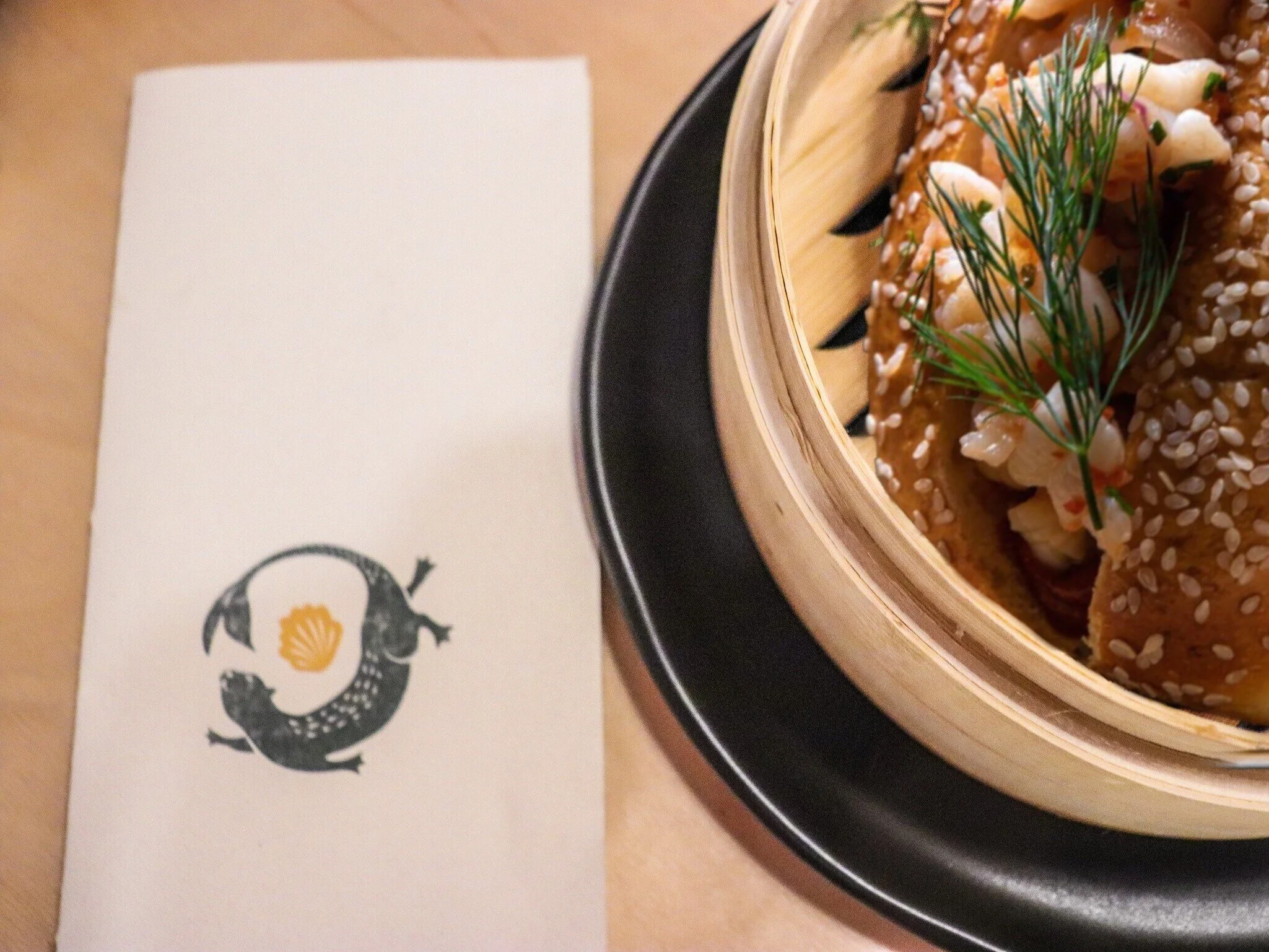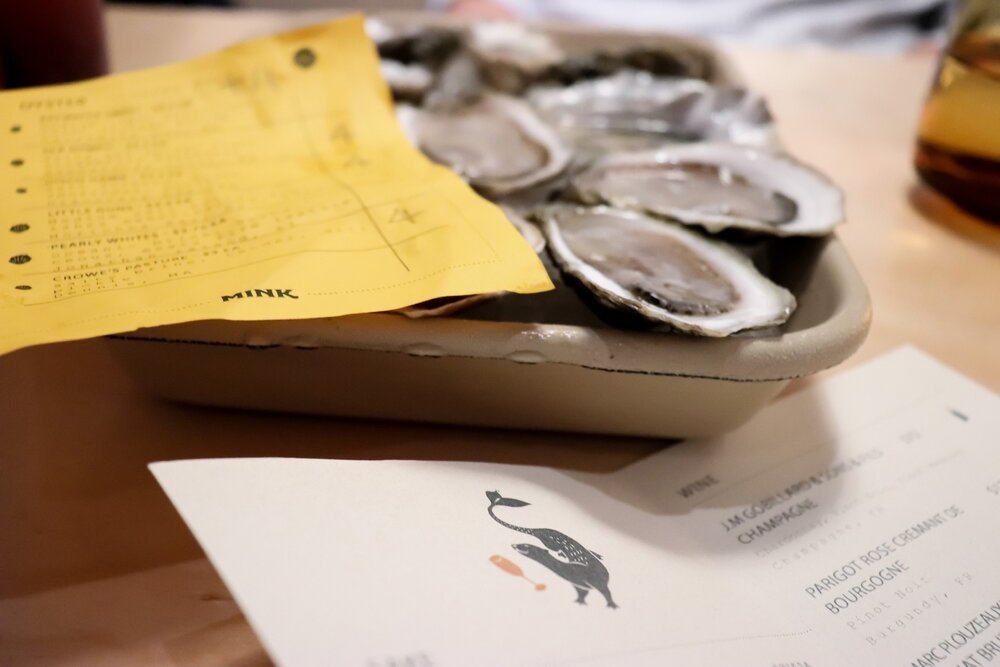Mink
Saké Flights, Shrimp Rolls, and Oyster Wallpaper: Detroit’s Little Raw Bar, Mink, Gets it Right
In my early twenties, my roommate Katherine and I spent nearly every weekend restaurant-hopping up and down Michigan Avenue—the cobblestone “yellow brick road” of the dining scene in the Corktown neighborhood of Detroit. We were lucky enough to land our first out-of-college jobs when Detroit began experiencing the rumblings of its now-fervent cultural renaissance, and, thus, had some spare change to enjoy the city’s offerings. Every week, a new restaurant seemed to pop-up right outside our door. It was magical to watch a city that had undergone so much economic strife literally come to life before our eyes.
* * *
As Katherine and I watched restaurants in Detroit pop-up faster than houses on a monopoly board, we noticed that one thing was missing—a raw bar. Sure, there were restaurants that had a bivalve offering or two, but there was nowhere devoted to showcasing the oyster and providing a regional variety to satiate and educate a Midwestern audience.
In late 2017, raw bar Voyager opened its doors in a suburb of Detroit called Ferndale—located about 20 minutes North of the city proper. Voyager was and still is a superb addition to the Michigan dining scene, and a wonderful showcase of raw bar goodness. In fact, I popped in Voyager almost weekly for a fresh dozen when they first opened.
We loved our roommate dinner dates at Voyager. But we were always waiting for a raw bar to take up residence in the heart of downtown Detroit.
* * *
This past holiday season, Katherine and I journeyed back to Detroit from California (Katherine) and Maine (myself). We brought back with us our West Coast vs. East Coast oyster rivalry that had been brewing for years, and had only escalated to a friendly fervor since our respective relocations.
We were delighted to learn a raw bar by the name of Mink had opened up in the Corktown neighborhood where we had spent so many weekends together gallivanting. With rumors of a fantastic selection of both West and East Coast oysters, we figured it would be a great opportunity to reignite our coastal oyster rivalry and enjoy an evening together at a new hotspot.
The Background on Mink
Mink is the inventive re-imagining of the classic New England raw bar combined with the synergetic and culinary curiousness of the modern Detroit restaurant scene. One of the most unique aspects of the restaurant industry in Detroit—which is gaining traction in other foodie cities—is the collaboration that exists between owners of different restaurants. Restauranteurs and chefs in Detroit recognize their competitors’ strengths; instead of fearing them, they form dining partnerships to showcase and hone one other’s skills and develop outstanding collaborative restaurants.
Mink is owned by Nest Egg, LLC, a joint venture created in 2019 between two all-female teams of Detroit chefs and restaurant-owners. Nest Egg, LLC is a fusion between restaurateurs Kiki Louya and Rohani Foulkes, chefs and owners of the all-day brunch café Folk, and Ping Ho and Sarah Welch, co-owners of Marrow, a heavily praised restaurant with its own butcher shop in West Village. The all-female quartet is believed to be the first partnership of its kind in the Detroit restaurant scene.
Taking the helm at Mink is Chef Cameron Rolka, also of Marrow. Chef Rolka is expanding his role at Mink beyond the confines of the kitchen, and is immersing himself in the oyster farms and growing techniques of various regions in the U.S. Rolka’s hands-on and educational approach to cooking demonstrates versatility as a chef, and also a respect for aquaculture.
Oyster Wallpaper: A Bivalve Lover’s Dream Decor
Mink’s intimate 25-seat restaurant is reminiscent of the New England raw bar giants Saltie Girl and Neptune Oyster of Boston, and Eventide of Portland. These New England hotspots have time-and-time again demonstrated that coveted seating options skyrocket demand. Mink has a sleek modern look designed by Studio AI Architects. The interior features an L-shaped bar overlooking Mink’s kitchen and petite raw bar. And to satiate every bivalve lover’s dream, Mink’s accent wall is adorned in a black-and-white oyster wallpaper custom-created by The Detroit Wallpaper Co. using bivalve illustrations by artist Nancy Pappas. Katherine stated she had to sit next to the wall of oyster wallpaper – this was absolutely non-negotiable. I never would have fought her on this as the oyster wall is just too perfect to pass up.
The Saké Selection
Before I even reviewed the raw bar offerings, Mink’s beverage menu was the first indication to me that the team had gotten the raw bar thing right. I was beyond delighted to see that Mink offered a saké tasting menu as part of its beverage program. Oysters and sake are the perfect marriage culturally and scientifically. Saké, in my opinion, is a very underutilized and unappreciated beverage in U.S. seafood restaurants, especially in the Midwest. Saké boasts high levels of glutamic and succinic acids, which are amino acids responsible for producing that “umami” flavor. Oysters, too, are high in amino acids, particularly glutamic and succinic acids. Thus, saké compliments and deepens the umami flavor of oysters without overpowering the bivalve’s taste.
Mink’s saké line-up is an indication the team has done its research. The list includes the delicious Manotsuru “Bulzai”Ginjo, a medium saké with eucalyptus and tropical fruit notes that pairs well with refreshing West Coast bivalves, and the delectable Manotsuru “Demon Slayer” Tokubetsu Honjozc, a supremely dry saké with notes of brown rice and green olives that perfectly compliments a briny East Coast oyster.
The Menu
Mink’s dinner menu features a selection of rotating bites. Katherine and I melted over the Shrimp Roll, which features local Michigan Shrimp sautéed with brown butter and dressed up in chili jam and endless herbage brimming to the top of a delicious steamy homemade brioche bun (even sliced the New England way!). We also ate every morsel of the bowl of steamed Manilla clams bathing in a broth with bok choy, fingerling potatoes, and housemade Txistorra sausage (a nod to Mink’s sister restaurant and butcher shop, Marrow). With so many delicious bites of seafood goodness, it is clear the dinner menu at Mink is not an afterthought.
West Coast vs. East Coast: The Battle Continues
For the evening’s main oyster event, Katherine and I carefully selected a diverse dozen, with representatives from the both coasts. The bivalve selection at Mink rotates on a daily basis, an indication that the oysters you are slurping are always fresh. My favorite thing to do at raw bars is compare and contrast oyster tastes and oyster shells, which is even more fun when you have oysters from different coasts.
Tasting Notes
The following bivalve beauties made it onto our dinner table that evening:
Baywater Sweets: These oysters hail from Thorndyke Bay in Washington State, and are farmed by legendary shellfish scientist Joth Davis of Baywater Shellfish Company. These petite bivalves are tide-tumbled and are meaty and deep-cupped with a mouthful of light brine with a clean, sweet avocado finish.
Sea Nymphs: If the name of this oyster doesn’t harken images of the sea, its salty sea spray flavor certainly will. Sea Nymphs originate from Hammersley Inlet, and are farmed by South Sound Mariculture. These bivalves are grown in mesh bags in the tidal waters of the inlet, and are finished on the beach, which gives their shell a lacy appearance akin to a piece of fresh ginger root. The underlying strawberry and kelp notes of the Sea Nymph paired exceptionally well with the Manotsuru “Bulzai.”
Little Guns: These not-so-little East Coast bivalves hail from Moriches Bay, a lagoon on the south shore of Long Island, New York. The bay is comprised of salt marshes and intertidal flats—the perfect brackish environment for oysters to thrive. Little Guns have an upfront taste of sharp brine that mellows into a sweet, buttery goodness.
Crowe’s Pasture: Crowe’s Pasture oysters are grown within Cape Cod’s Conservation Land. The first slurp of a Crowe’s Pasture oyster begins with that familiar salty East Coast brine, and then a second wave of light dill follows. These paired excellently with the hints of olive in the Manotsuru “Demon Slayer” Tokubetsu Honjozc.
A Promising Future
Katherine and I had the opportunity to chat with Chef Rolka between shucks, and he gave us a sneak peek into Mink’s future plans. The neighborhood shop would begin offering shucking classes to eager Midwestern patrons, and would also be continuing to diversify its oyster offerings with several more farms added to the menu. It is a hope that these classes would not only teach shucking skills to diners, but would also inspire them to pursue their own oyster adventures to other parts of the country. Chef Rolka himself had some more travel plans for 2020, as he would continue to explore oyster farms in different geographic regions of our country to expand his repertoire of aquaculture.
* * *
Katherine and I left Mink fully satiated, our stomachs filled with bivalves and saké. As we walked into the Detroit winter, we vowed that our friendly west coast vs east coast oyster rivalry would (forever) continue, and we needed to expand our raw bar explorations to parts unknown. But without a doubt, we were beyond happy to know that an amazing raw bar with an appreciation and respect for the aquaculture industry had finally taken up residence in the Detroit neighborhood we love.
To read more about Mink or book a reservation, please visit its website here: Mink.


